Technical Requirements for Accessible Hiker/Pedestrian Trails
Section 7.4 of FSTAG explains the accessibility requirements for trails, including trail surfacing, clear tread width, grade and cross slope, resting intervals, passing spaces, tread obstacles, protruding objects, openings, and signs. All of these requirements are minimums. In the spirit and intent of universal design, designers are encouraged to meet the highest standards wherever it is practicable, given the specific natural constraints of the environment, the level of development, and other managerial considerations. Trail puncheons and trail bridges are included in the Forest Service definition of trail structures, so they must be constructed to meet the same requirements as the rest of the trail tread. In the following text, the word "trail" includes trail puncheons and trail bridges.
Wheelchair dimensions, clear space, maneuvering room, and reach ranges found in Architectural Barriers Act Accessibility Standards (ABAAS) are the basis for trail designs that maximize accessibility and are appropriate to the setting. The dimensions, multiple moving surface contact points, and wheels of a wheelchair are usually the most difficult to accommodate. If a person who uses a wheelchair can use a trail, a majority of other people can, too.
The rest of this part of the guidebook explains the technical accessibility requirements for trails and provides an overview of the FSTAG implementation process and a flowchart of the FSTAG implementation process. The flowchart is designed to be used while laying out the flag line for a trail.
Surfaces of Trails
Trail surfaces must be firm and stable. The first general exception allows achieving firmness and stability to the extent practicable if a condition for an exception prohibits full compliance with surface requirements.
Paving with concrete or asphalt is appropriate for highly developed areas. For less developed settings, crushed gravel, fine crusher rejects, packed soil, and other natural materials may provide a firm and stable surface (figure 128). Natural materials also can be combined with synthetic bonding materials that provide stability and firmness. These materials may not be suitable for every trail, which is why the deviation due to the presence of a condition for an exception is permitted.
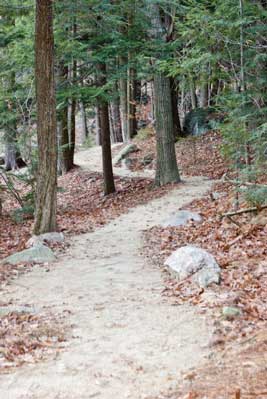
Figure 128—Natural materials were used to build a firm and stable surface for the Crotched Mountain Trail in New Hampshire.
Slip resistance is not required for trails. Tree and shrub leaves and needles, dirt, ice, snow, other surface debris, and weather conditions are part of the natural environment and would be difficult, if not impossible, to avoid.
FSTAG defines a firm surface as one that resists deformations by indentations. (See DESIGN TIP—Use a rule of thumb to estimate firmness and stability., page 37.) Natural soils should be evaluated for their ability to be compacted into a firm and stable surface under normally occurring weather conditions during the primary season of use. When evaluating surface material suitability, keep in mind that FSTAG defines a stable surface as a trail surface that is not permanently affected by normal weather conditions and that is able to sustain wear and tear produced by normal use between planned maintenance cycles. Local trail managers are a good source of information because they know the local surfaces and how they wear throughout the primary seasons for which the trail is managed.
Clear Tread Width of Trails
Clear tread width is the width of traveled surface between obstacles on the ground and above the ground (figure 129). Provide at least 36 inches (915 millimeters) of clear tread width. An exception permits the width to be reduced to 32 inches (815 millimeters) minimum if a condition for an exception prevents the wider tread. If even the reduced width of 32 inches can't be met due a condition for an exception, the first general exception allows achieving the width requirement to the extent practicable.
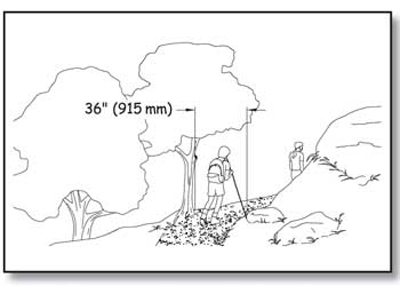
Figure 129—The requirements for clear tread width on a trail.
Trail Slopes
Trail slopes must meet the requirements that follow. Steeper terrain makes it difficult to achieve flat grades everywhere. Many people are able to handle steeper slopes for short distances. Short sections of steeper trail are allowed so that trails can be constructed in varying terrain. The first general exception allows achieving trail slopes to the extent practicable if a condition for an exception prohibits full compliance with slope requirements
Running slope is the lengthwise slope of a trail, parallel to the direction of travel. In this guidebook, the terms running slope and grade often are used interchangeably. Trails or trail segments of any length may be constructed with a running slope ratio of up to 1:20 (a 5-percent grade). To accommodate steep terrain, trails may be designed with shorter segments that have a running slope (grade) and length as shown in table 5.
Table 5—Trail running slope and segment length.
| Running Slope of Trail Segments | Maximum Length of Segment Between Resting Intervals | |
|---|---|---|
| Steeper than | But no Steeper than | |
| 1:20 (5 percent) ) | 1:12 (8.33 percent) | 200 feet (61 meters |
| 1:12 (8.33 percent) | 1:10 (10 percent) | 30 feet (9 meters) |
| 1:10 (10 percent) | 1:8 (12 percent) | 10 feet (3.05 meters) |
Provide a resting interval between each of these steeper slope segments. To ensure that the trail is not designed as a series of steep segments, do not exceed a grade of 1:12 (8.33 percent) for more than 30 percent of the total length of the trail. The running slope (grade) must never exceed 1:8 (12 percent).
Construction Tip
Slope and grade terminology.
Slopes are often described as a ratio of vertical distance to horizontal distance, or rise to run (figure 130). For instance, a slope ratio of 1:20 means that for every foot of vertical rise, there are 20 feet of horizontal distance (or for every meter of vertical rise, there are 20 meters of horizontal distance).
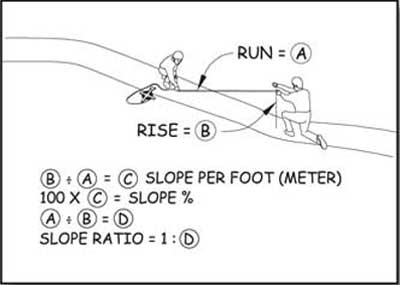
Figure 130—Determining the slope ratio.
Cross slopes—the side-to-side slope of a trail tread (figure 131)—provide drainage to keep water from ponding and damaging the trail, especially on unpaved surfaces. Cross slopes that are too steep can be difficult to traverse, but trails with too little cross slope tend to become streams. Water running down or ponding on trails destroys them. Cross slopes are an important part of trail design and construction.
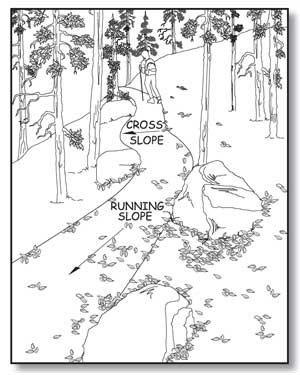
Figure 131—The running slope is measured along a trail's length; the cross slope is measured across its width.
Ensure that cross slopes do not exceed 1:20 (5 percent). If the trail surface is paved or built with boards, however, do not allow the cross slope to be steeper than 1:48 (2 percent).
Resting Intervals on Trails
Resting intervals are relatively level areas that provide an opportunity for people to stop and catch their breath. Provide resting intervals between each trail segment any time the running slope exceeds 1:20 (5 percent) as shown in table 5. Ensure that the resting interval is at least 60 inches (1,525 millimeters) long and at least as wide as the widest segment of the trail tread leading into it, if the resting interval is within the trail (figure 132). If the resting interval is beside the trail, ensure that it is at least 60 inches (1,525 millimeters) long and at least 36 inches (915 millimeters) wide. If the resting interval is adjacent to the trail tread, provide a turning space complying with ABAAS section 304.3.2. This doesn't mean that another space must be provided for turning around or as a passing space in addition to the resting space. The resting space itself may also serve as the turning and passing space if it is at least 60 inches (1,525 millimeters) in diameter or is T-shaped with a minimum 60- by 36-inch (1,525-by 915-millimeter) arm and a minimum 36-inch (915-millimeter) -wide by 24-inch (610-millimeter) -long base (figure 133).
Design Tip
The cross slope requirement depends on what material is used.
Those who use a manually operated wheelchair or a walker know that as cross slope increases, travel becomes more difficult. This is because working against the sideways pull of the cross slope can double the effort needed to make forward progress. However, in an outdoor environment, the cross slope has to be steep enough that water won’t accumulate on the travel surface. While slope and drainage can be precisely controlled on surfaces that are paved (asphalt, concrete, paving blocks, and so forth) or built with boards (wood planks, heavy timber, concrete, fiberglass, or other manufactured material), it’s more difficult to ensure drainage on natural or gravel surfaces. When water accumulates on natural or gravel surfaces, they often become muddy and impassible. That’s why the cross slope is allowed to be steeper on natural or gravel surfaces than on surfaces that are paved or built with boards.
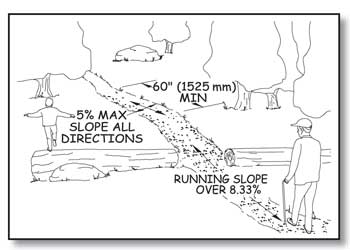
Figure 132—The requirements for resting intervals.
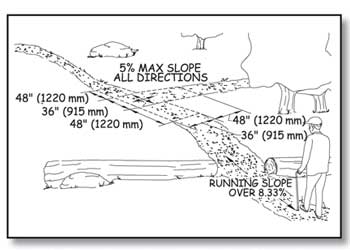
Figure 133—The requirements for a resting interval at a T-intersection.
The slopes of a resting interval must not exceed 1:20 (5 percent) in any direction. However, when the surface is paved or is built with boards, the slope is not allowed to be steeper than 1:48 (2 percent) in any direction. No significant difference in vertical alignment between the trail tread, turning space, and resting interval is allowed where they meet. The first general exception allows achieving resting interval requirements to the extent practicable if a condition for an exception prohibits full compliance with the requirements.
Passing Spaces on Trails
A 60-inch (1,525-millimeter) clear tread width is required for two wheelchairs to pass safely and comfortably on a trail. However, this width is not always appropriate in all settings and for all trail classes. Where the clear tread width of a trail is less than 60 inches (1,525 millimeters), provide passing spaces at least every 1,000 feet (300 meters) and at the end of any segment of trail that meets the technical requirements, if the full length of the trail does not. Passing spaces must be at least 60 inches (1,525 millimeters) wide (including the trail width) by 60 inches (1,525 millimeters) long (figure 134). A T-intersection of two trails or other walking surfaces also may be used as a passing space if the arms and stem of the T-shaped space extend at least 48 inches (1,220 millimeters) beyond the intersection (figure 135). Either configuration would provide enough room for someone to move to the side. If a condition for an exception prevents achieving full compliance with the passing space requirements, the first general exception allows achieving passing space requirements to the extent practicable.
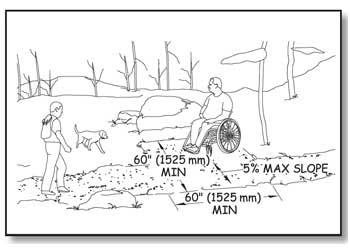
Figure 134—The requirements for passing spaces.
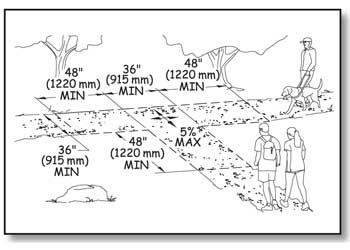
Figure 135—The requirements for passing spaces at T-intersections.
Tread Obstacles on Trails
A tread obstacle is anything that interrupts the evenness of the tread surface. On trails, tread obstacles often occur as a result of ruts, roots, and rocks in the tread surface. Ensure tread obstacles are not more than 2 inches (50 millimeters) high. Where the surface is paved or is built with boards, ensure tread obstacles do not exceed one-half inch (13 millimeters) in height. Height of tread obstacles must be measured vertically from the trail tread surface to the highest point of the obstacle. If a condition for an exception prevents achieving full compliance with the obstacle height requirements, the first general exception allows achieving the requirements to the extent practicable.
Protruding Objects and Trails
Objects that extend into the travel way of a trail from the side or from overhead can be hazardous to people who are paying more attention to their companions than the travel route (figure 136), as well as to people who are blind or have low vision. Protruding objects are defined as constructed features such as signs that extend into the clear width area of a trail, resting interval, or passing space between 27 inches (685 millimeters) and 80 inches (2,030 millimeters) above the travel surface. Do not allow protruding objects to extend into the clear width area more than 4 inches (100 millimeters).
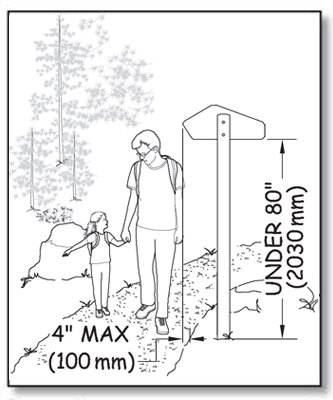
Figure 136—Constructed objects must not extend over the trail more than 4 inches (100 millimeters) if they are between 27 inches (685 millimeters) and 80 inches (2,030 millimeters) above the travel surface.
Accessibility guidelines do not consider natural elements such as tree branches and rock formations to be protruding objects. However, you should follow the specific Trail Management Objectives for each trail that address protrusions, obstacles, and clearing widths and heights. For instance, trails should generally not be routed too close to rock overhangs. Clearing limits for trail construction and maintenance usually require that brush, limbs, trees, and logs be cut back a foot or more from the edge of the trail. However, the trail maintenance cycle may be several years for some trails, and vegetation may encroach on the trail during the interim. The protruding object requirement recognizes that it may not always be practicable to control vegetation, but it is always practicable to place constructed features where they won't interfere with hikers. It also recognizes situations where rock ledges are unavoidable or where trails pass through caves (figure 137).
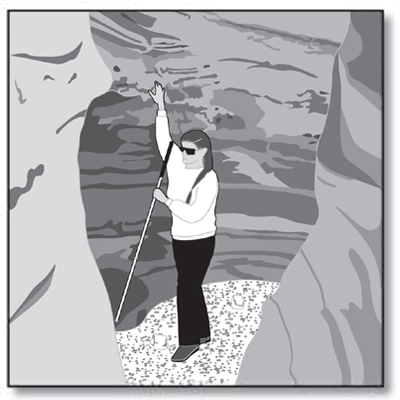
Figure 137—Protruding object requirements do not apply to natural features, such as caves in undeveloped areas.
Openings in Trail Surfaces
Openings are gaps in the surface of a trail. Gaps include slots in a drainage grate and spaces between the planks on a puncheon, bridge, or boardwalk. Openings that are big enough to allow wheels, cane or crutch tips, or shoe heels to drop through or get stuck are hazards that shouldn't exist in pedestrian routes. Openings up to a half of an inch (13 millimeters) across are permitted in trail surfaces. Place elongated openings more than a quarter of an inch wide with the long dimension perpendicular or diagonal to the primary direction of travel (figure 138).
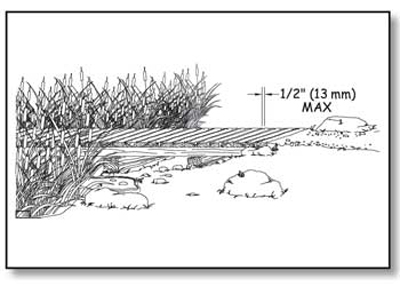
Figure 138—The requirements for openings that are perpendicular to the direction of travel on trail surfaces, such as boardwalk decking.
If there is a condition for an exception, openings less than three-fourths of an inch (19 millimeters) across are allowed. This deviation allows the use of boardwalk decking that needs more than ½-inch (13-millimeter) -wide spacing between the planks to permit expansion and to allow water to drain. If even the three-fourths of an inch deviation is not enough, General Exception 1 allows achieving trail surface opening requirements to the extent practicable if a condition for an exception is present.
Trail Facilities
To comply with the Architectural Barriers Act of 1968 (ABA) and Section 504 of the Rehabilitation Act of 1973, trail facilities such as tent pads and platforms, camp shelters, pit toilets, viewing areas, and similar structures for trail users that are provided along trails—even trails that are not accessible— must be designed to comply with the applicable provisions in FSORAG, except that slopes not steeper than 1:20 (5 percent) are allowed if necessary for drainage of unpaved surfaces that aren’t elevated above the natural ground.
The path of travel between trail facilities, as well as the path connecting them to a trail, must comply with FSTAG. These paths are not outdoor recreation access routes and are not required to meet the technical requirements for an outdoor recreation access route.
Trail facilities must be designed appropriately for the setting and in compliance with the applicable provisions in FSORAG to ensure that the facility can be used for its primary purpose by all hikers, including hikers with disabilities. For example, if a camp shelter is provided along a trail and its floor is above the ground, all hikers must be able to get inside the shelter. As explained in "Camp Shelters" of this guidebook, this can be accomplished by ensuring the camp shelter floor is 17 inches (430 millimeters) minimum to 19 inches (485 millimeters) maximum higher than the camp shelter space at the shelter entrance. This height allows someone using a wheelchair or other assistive device to transfer onto the floor of the shelter.
Requirements for all recreation facilities, including those that are commonly associated with trails, are contained in FSORAG and explained in "Applying the Forest Service Outdoor Recreation Accessibility Guidelines" of this guidebook.
Gates and Barriers on Trails
If gates or barriers are constructed to control access to trails, include openings wide enough to allow hiker passage. Refer to the FSTAG for the technical provisions for gates and barriers. These requirements are also explained in "Getting From Here to There—Outdoor Recreation Access Routes" of this guidebook.
Trailheads
To comply with the ABA and Section 504 of the Rehabilitation Act of 1973, ensure that each constructed feature provided at a trailhead complies with the applicable provisions of FSORAG and ABAAS. Requirements for trailhead features, such as parking spaces, toilets, water spouts, and campsites, are explained in "Applying the Forest Service Outdoor Recreation Accessibility Guidelines" of this guidebook.
Because trailheads are usually accessed by vehicle rather than only by hiking, at least one outdoor recreation access route must connect the following places at trailheads:
-
Accessible parking spaces or other arrival point
-
Starting point of the trail
-
Accessible outdoor constructed features, elements, spaces, and facilities within the trailhead
In alterations to existing trailheads, where there is a condition for an exception, the technical requirements for the outdoor recreation access route that are affected by the condition for an exception must be achieved only to the extent practicable. If elements, spaces, or outdoor constructed features are altered at trailheads but the path of travel isn't changed, an outdoor recreation access route isn't required.
Design Tip
New trail facilities must be accessible even if the trail doesn't comply with Forest Service Trail Accessibility Guidelines.
The Architectural Barriers Act of 1968 (ABA) requires that buildings comply with the applicable accessibility guidelines. This issue was clarified for Federal agencies when a complaint was filed with the U.S. Access Board against the U.S. Department of the Interior, National Park Service for installing an inaccessible toilet at 10,000 feet (3,048 meters) on Mt. Rainer. The petitioner was a paraplegic who was climbing the mountain with a sit-ski and ropes. He was not able to use the toilet that the rest of his party could use because it wasn't accessible. The U.S. Access Board found that the National Park Service was not in compliance with ABA that requires all new construction funded by Federal Executive agencies to be accessible. The National Park Service settled the complaint by replacing the toilet with an accessible model.
The Forest Service was cited by the U.S. Access Board after a complaint was filed about a pit toilet serving the trail at North Doublehead in New Hampshire. The toilet was constructed in 1972 after the 1968 passage of the ABA, but the toilet was not accessible. The Forest Service replaced the toilet with an accessible model.
It's really in the best interests of all organizations to ensure that all facilities—regardless of where they are located—are appropriate to the setting and are accessible. When accessibility is integrated into the design from the beginning, there's not much difference in cost. If the design of a facility that's already under construction must be changed to provide for accessibility, or if an inaccessible facility has to be replaced with an accessible facility at a later date, costs will be substantial.
To quote a hiker with a Northeast Passage hiking team that includes a diverse group of people (figure 139): "Hiking a trail is a challenge by choice; using a toilet is not a choice so it shouldn't be a challenge."
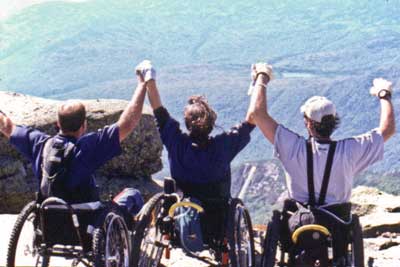
Figure 139—Three members of the Northeast Passage hiking team celebrate their conquest of Mount Lafayette in New Hampshire. Photo credit: Northeast Passage, Durham, NH
Trailhead Signs
People have made it clear that they want information about trails, including length, grade, and so forth, so that they can make their own decisions about which trail is appropriate for the amount of time they have available, the people in their group, and the type of hike they are interested in pursuing. Therefore, when new information signs are provided at trailheads for newly constructed or altered trails, include at minimum the following information:
-
Trail name
-
Length of the trail
-
Type of surface on the trail
-
Typical and minimum trail tread width
-
Typical and maximum trail grade
-
Typical and maximum trail cross slope
-
Height of any major obstacles, such as boulders, in the trail tread
-
A statement that posted information reflects the condition of the trail when it was constructed or assessed, including the construction or assessment date
The requirement for posting the construction and trail assessment date is because tree blowdowns, flooding, or other events can make trails designed and constructed to FSTAG standards temporarily inaccessible until maintenance crews can clear the obstruction. If the date is posted, people will be able to evaluate the likelihood that the trail remains in the posted condition. For instance, people may know that a major storm has occurred since the conditions were posted or may estimate the likelihood that vegetation may have overgrown the trail since the condition was evaluated.
Where more extensive trail information such as an aerial map of the trail and related facilities is provided, identify the location of specific trail features and obstacles that do not comply with FSTAG's technical requirements and include a profile of the trail grade.
If materials, such as maps, brochures, fee envelopes, and so forth, need to be obtained from or filled out at a sign or kiosk, design the sign or kiosk to display the materials within the standard reach ranges of a person in a wheelchair in accordance with ABAAS, section 308, as explained in "Reach Ranges and Operability Requirements" of this guidebook.
Locate trailhead information signs centered at the back of a 30- by 48-inch (760- by 1,220-millimeter) -minimum clear floor or ground space. Do not allow the clear space to overlap the trail width but it may overlap a resting space or passing space. The slope of the clear space is not allowed to be more than 1:20 (5 percent) in any direction.
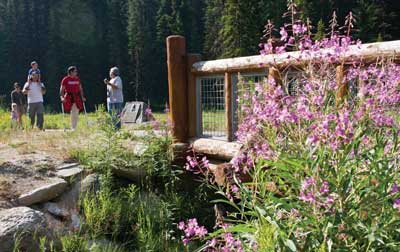

User Comments/Questions
Add Comment/Question